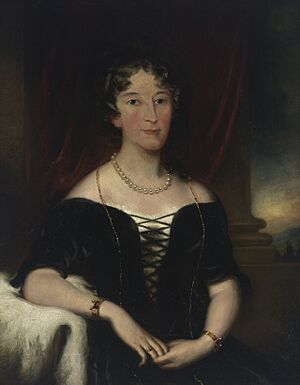Elizabeth Macarthur facts for kids
Quick facts for kids
Elizabeth Macarthur
|
|
|---|---|

An oil painting of Macarthur by an unknown artist
|
|
| Born |
Elizabeth Veale
14 August 1766 |
| Died | 9 February 1850 (aged 83) Clovelly, New South Wales
|
| Nationality | British |
| Occupation | Pastoralist and merchant |
| Spouse(s) |
John Macarthur (m. 1788–1834)
|
| Children | 8; including:
|

Elizabeth Macarthur (born 14 August 1766 – died 9 February 1850) was a remarkable woman who played a significant part in the early history of the Australian colony of New South Wales. She is well-known as the wife of John Macarthur, and for her crucial role in helping to establish Australia's wool industry.
Contents
Early Life and Journey to Australia
Elizabeth Veale was born in Bridgerule, England. Her parents, Richard and Grace Veale, were farmers. When Elizabeth was only four years old, her father passed away. Later, when she was 11, her mother remarried, and Elizabeth was cared for by her grandfather, John, and a family friend.
In 1788, Elizabeth married John Macarthur, a soldier from Plymouth. Two years later, in 1790, she embarked on a long journey to the newly established colony of New South Wales. She travelled with her husband and their newborn son, Edward, as part of the New South Wales Corps on the Second Fleet. This was a difficult and dangerous voyage, but Elizabeth bravely faced the challenges of moving to a new, unknown land.
Life in the New Colony
Elizabeth Macarthur was the very first soldier's wife to arrive in New South Wales. She was an educated, articulate, and well-read woman. Her letters from this time are very important because they give us a detailed look into what life was like in the early convict town of Sydney and the developing colony. She was also interested in science, enjoying amateur astronomy and botany.
Elizabeth held a respected position in the early colonial society. She was known for her charm and good manners, which helped her and her children maintain a good social standing. This was especially important because her husband, John, was often involved in disagreements and controversial actions.
In 1793, John Macarthur was made Commandant at Parramatta and received land grants nearby. He named their property Elizabeth Farm in honour of his wife. John also became the paymaster for the New South Wales Corps and oversaw public works. However, because of John's many business activities and conflicts, the Macarthur family's social connections with the governors became limited after Governor Phillip.
Elizabeth's main focus was her family, ensuring her children received a good education, and managing their household. She lived a long life, passing away in 1850. She had survived her husband by 16 years, continuing to manage their family's affairs after his death.
Building Australia's Wool Industry
Elizabeth Macarthur played a truly vital role in the success of the Australian wool industry. Her husband, John, spent significant time in England between 1801 and 1805, and again from 1808 to 1817. During these long periods, Elizabeth was in charge of managing all the family's large estates, including Elizabeth Farm, Camden, Seven Hills, and Pennant Hills.
Her responsibilities were huge. She managed all the household and business accounts, oversaw the convict labourers who worked on the farms, and supervised the entire process of wool production – from washing and baling the wool to arranging its transport. Most importantly, she was responsible for selecting the best rams and managing the breeding of their sheep to improve the quality of the flock.
While John was in England promoting Australian wool, Elizabeth was the one on the ground, making sure the wool was actually produced. Her excellent organisational skills and dedication were essential to the success of their sheep farming business. Her hard work helped establish New South Wales as a reliable supplier of high-quality wool to the world.
Even after her husband's health declined and after his death in 1834, Elizabeth continued to run their farming enterprises with great success until her own death in 1850.
Personal life
Seven of Elizabeth's eight children survived childhood. Their sons, Edward (1789–1872), John (1794-1831), James (1798-1867), and William (1800-1882), all made important contributions to the colony in areas like government, agriculture, politics, and trade.
Their eldest daughter, Elizabeth (1792-1842), remained unmarried. Her younger daughters, Mary (born 1795) and Emmeline (born 1808), married into other notable colonial families.
- Sir Edward Macarthur (1789–1872) married Sarah Neil in 1862, but they did not have children.
- James Macarthur (1798–1867) married Emily Stone. They had one child, a daughter named Elizabeth (1840-1911).
- Sir William Macarthur (1800–1882) never married.
The majority of the Macarthur family's wealth and land eventually passed to James's only child, his daughter Elizabeth (1840-1911). In 1867, she married Arthur Onslow (1833–1882). After Arthur's death, Elizabeth changed the family name to Macarthur-Onslow in 1892, continuing the family's legacy. They had six children.
Legacy
Elizabeth Macarthur's contributions to Australia are still recognised today.
The Elizabeth Macarthur Agricultural Institute is named in her honour. It is the largest Centre of Excellence operated by the New South Wales Department of Primary Industries, employing 200 scientists and located at Camden Park. This institute continues her legacy of agricultural innovation and development.
Elizabeth Macarthur is also commemorated on a special 1995 Australian five-dollar coin. This coin was part of a collector's set called Masterpieces in Silver, celebrating Colonial Australia. In 2001, she was recognised for her achievements by being inducted onto the Victorian Honour Roll of Women.
Her life and experiences have also inspired modern works, such as the fictional memoir A Room Made of Leaves by Australian author Kate Grenville, published in 2020.

